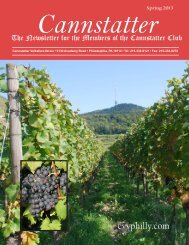Cannstatter Volksfest Verein
Cannstatter Volksfest Verein
Cannstatter Volksfest Verein
You also want an ePaper? Increase the reach of your titles
YUMPU automatically turns print PDFs into web optimized ePapers that Google loves.
www.cvvphilly.com<br />
Swabian/Schwäbisch<br />
By David Roscoe<br />
Many of our members are several generations<br />
removed from their immigrant ancestors and in a<br />
desire to reconnect with their roots have signed up for<br />
a German language course, a decision which I<br />
applaud. In their course they study standard German<br />
or High German - Hoch Deutsch - but High German is<br />
something of an artificial<br />
language first developed by<br />
Martin Luther in his<br />
translation of the Bible. He<br />
attempted to develop a<br />
language which combined<br />
features of the dialects<br />
spoken in the mountainous<br />
regions of central and<br />
Southern Germany, hence<br />
the term High German as<br />
opposed to Low German or<br />
the dialects spoken in the<br />
low areas of Northern<br />
Germany.<br />
Despite Luther’s effort the<br />
local dialects persisted<br />
although High German was<br />
taught in the schools.<br />
Someone once described a<br />
language as a dialect with<br />
an army and navy so the<br />
Low German dialects spoken<br />
in the Netherlands and<br />
England became Dutch and<br />
English instead of just being local dialects.<br />
In the area of Southwestern Germany from where the<br />
founders of the <strong>Cannstatter</strong> came, the local dialect<br />
was Swabian or Schwäbisch and variants are spoken<br />
in Switzerland as well as Alsace. Many of the socalled<br />
Pennsylvania Dutch came from this region and<br />
they speak a form of German very close to Swabian.<br />
There are several aspects of Swabian which<br />
differentiate it from formal standard German. Perhaps<br />
Map of the Swabian Circle 1572<br />
the most obvious is a vowel switch where for example<br />
the round “a” becomes a long “o” and as a result a<br />
Schwab is called a Schwob. The umlauted “o” as in<br />
schön where it is pronounced like “er” but in Swabian<br />
it becomes pronounced like English long “a”, as in<br />
hay. Diminutives are not formed by the suffix “es,”<br />
“chen” or “lein” as in<br />
Hänschen and Gretchen but<br />
with “el” so we have Hänsel<br />
and Gretel.<br />
Another characteristic of<br />
Swabian is the dropping of<br />
the “ch” is words such as<br />
ich, auch and nicht which<br />
then become “i” -<br />
pronounced as English long<br />
“e” as in see - au -<br />
pronounced owl - and nit.<br />
The “ch” is not the only<br />
thing dropped. Adjective<br />
endings and verb endings<br />
are too, as well as interior<br />
consonants and vowels, so<br />
you can hear such phrases<br />
as Mir han instead of wir<br />
haben - oops I neglected to<br />
point out that the labials<br />
“w” and “m” are sometimes<br />
interchanged.<br />
These are but a few of the characteristics which<br />
distinguish Swabian from standard German and which<br />
make the local dialect interesting and individualistic.<br />
Field Marshall Erwin Rommel - no relation to our past<br />
president - according to his biographer, enjoyed<br />
speaking in the dialect to people from Swabia. If you<br />
are - as I have often advised - taking a course in<br />
German, ask your instructor about some of these<br />
differences and set the class in a fun direction.<br />
15



